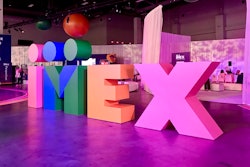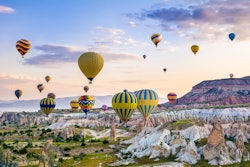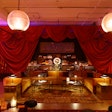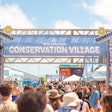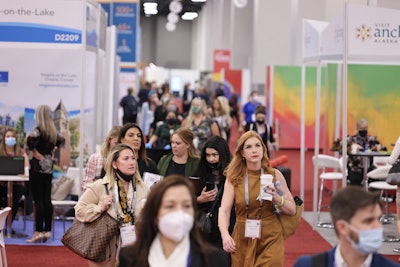
LAS VEGAS—"We're back in business," proclaimed IMEX Group CEO Carina Bauer at the closing press conference of the 10th edition of IMEX America, which took place in Las Vegas from Nov. 9-11. The annual trade show for the global meetings industry was certainly back in a big way, filling the Mandalay Bay Convention Center with almost 9,000 people—including 3,300 buyers and 2,200 exhibiting companies representing over 200 countries.
Those numbers were no small feat in the middle of a global pandemic—particularly when the majority of international attendees and exhibitors weren't sure if COVID-19-related travel restrictions would be lifted in time for the event. But luck was on the team's side, and the U.S. opened its borders vaccinated foreign travelers on Nov. 8.
Other than serving as a sort of international industry reunion, highlights of the trade show included more than 200 educational sessions, along with a variety of new features that reflected the industry's current reality. Among them: a new People & Planet Village with a focus on sustainability, CSR and diversity; a large event tech section on the show floor featuring a variety of virtual platforms, many of whom were exhibiting for the first time; and a first-of-its-kind broadcast studio with programming for virtual attendees.
BizBash caught up with Bauer during the show to learn what it was like planning one of the pandemic-era's first international trade shows. Read on to learn why the team instituted a vaccine mandate, the challenges of accomodating an international audience, just how many times the floorplan had to be redrawn and more.
First of all, what was it like planning a 10,000-attendee trade show in Las Vegas while you’re based in the United Kingdom? I imagine due to COVID restrictions, most of your team members couldn’t just pop over for site visits. IMEX Group CEO Carina BauerPhoto: Courtesy of IMEX Group
IMEX Group CEO Carina BauerPhoto: Courtesy of IMEX Group
We did a lot of Zoom calls or Teams calls, and they sent us maps and we sort of reacquainted ourselves. Myself and our operations director were able to get out here in September and walk through. Like everybody else, we just had to make do, really—but it was helped very much by the team at Mandalay and the team at GES.
During the pandemic, you hosted two great virtual events called PlanetIMEX. Do you remember when you made the decision that in 2021, you’d return face to face?
Well, our business is face to face. Our business is this trade show. Our virtual events were an opportunity for us to give back to our community, to keep them together, to reconnect people with each other—but it was never our new business. So, we always knew that as soon as we were able to go back face to face, we would. And also, all through this period, we've been in very close contact with our exhibitors and with the buyer communities, and they told us they were ready as well.
So, in a way, it wasn't a specific decision. It would've been a decision not to do it, if you like. The question was: Is it viable? Is it safe? Are the other conditions right that we can put on a show that we would be proud of?
Once the vaccine started rolling out, we could see the difference that was making in terms of that break between case numbers and deaths. So we felt fairly confident that by the time we got to November, we should be able to hold a successful show. You never know until you are closer, but we were pretty confident by spring 2021.
When you picked the dates of Nov. 9-11, did you know the United States’ travel ban for vaccinated foreign travelers would be lifted on Nov. 8?
We picked these dates in 2017. So no, I can hold my hand up and say it was luck!
Wow! Beyond the changing regulations, do you feel like there were extra challenges to bringing in an international audience right now? Ultimately, exhibitors came from more than 200 countries. Did you find much hesitation on their part to travel?
Actually, not hesitation. [There was] huge demand, and huge demand for more to be here than have managed to come. But there were major challenges because we didn't know until two weeks ago when the borders would open. And the fact that we have such a strong international presence here, I think is remarkable and amazing; we're so grateful to the international destinations and the hotel groups for really sticking. We gave them flexibility to push their decisions as late as they could, but they also were flexible with us. So it was a real partnership.
But also a huge challenge. The floor plan was redrawn about five times. You take a booth like Ireland, which has a big presence [here on the show floor]—and three weeks ago, they didn't know whether they'd have that or nothing. … Some of our Europeans had decided the day prior to the [Oct. 15] announcement that they would not be able to come, or they'd only be able to come with a very small booth, and they told all their suppliers and told their partners. The next day there was the announcement, and then they changed everything again. We are grateful for them really for their adaptability.
There were challenges with the supply chain as well. A show like this is an ecosystem of all those suppliers, and everybody really had to pull together to make it happen. We’ve all had to learn to be much more adaptable to that change and that uncertainty.
Why did you decide to require proof of COVID-19 vaccination for all attendees, and did you find much pushback there?
We were monitoring things all through the summer and we were talking to the other events that were running, and the venue, to see what the precedent was and what was happening. And then we saw, obviously, the Delta variant start. In talking to our key exhibitors and the buy-in groups, we could see that it would give people far more confidence in the safety of the show to do the vaccine mandate.
None of these things are 100% safe, but we felt that doing a vaccine mandate would significantly reduce the risk for everybody. And that, ultimately, it was about giving both our buyers and exhibitors confidence to come and have a good show. And so we just felt that that was the best way to do that—and that we needed to [announce] that early enough to give people a chance to make their plans. Some people might have gotten vaccinated as a result of it.
In terms of pushback, there was a little bit. I would say it was very minor—maybe tens of people. Obviously, we knew from the surveys that Freeman had done, that MPI had done, that the majority of [the business events] industry was vaccinated. So we felt quite confident that it would be well received. And it was—the number of positive comments far outweighed negative. On the show floor, I've heard people, buyers in particular, say that they wouldn't have come if it hadn't had a vaccine mandate. It’s really heartening that it had the impact that we had hoped. Attendees were asked to wear masks while walking to and from the show floor, in accordance with local guidelines, but were able to remove their masks while inside the main show.Photo: Courtesy of IMEX Group
Attendees were asked to wear masks while walking to and from the show floor, in accordance with local guidelines, but were able to remove their masks while inside the main show.Photo: Courtesy of IMEX Group
Masks are required indoors in Las Vegas right now, but you’re not requiring them on the show floor. How does that work?
So the governor of Nevada came out just before we made the final decision to say that shows that mandate the vaccine and check it, and have all the protocols in place, could apply for a license to be maskless. So that was what we did. We knew that that would make a massive difference to how people interact and feel about the show. Obviously, it's optional [to go maskless] and people have been very gracious. … But we know that there are a lot of people who really appreciate being able to be in this environment and not have that mask.
With the shift to the Mandalay Bay Convention Center after 10 years at Sands Expo and Convention Center, are there any layout changes that you think really worked?
In these new halls, we have more space, so I think the flow has been great. We've been able to, for example, locate the press center onto the show floor. We've been able to put the hosted buyer lounge and registration right by the show entrance. The show itself is quite nice too, because it's not like there's a front and a back simply because it's so long. So for the exhibitors, everything's quite visible because we did very wide perimeter aisles. It makes the show very open, because you can walk down and really see what's around.
Also because we had more space, we've been able to put many more big seating areas and food areas in the middle of the show, which we didn't have room for before. It makes the show a little bit easier to navigate, I think. We also did it to give people space if they didn't to be in a crowd [for health reasons]—we have lots of areas that they can go and just spread out and feel comfortable.
IMEX has really become known for its sustainability initiatives, which this year expanded into the new People and Planet Village, also focused on diversity, CSR and more—complete with an education area, hygiene kits for Clean the World, The Misfit Market featuring smoothies made from “imperfect” produce and even the chance to help construct a clubhouse for a child with pediatric cancer. Why did putting all of this under one umbrella make sense this year?
This was a new space to bring all the CSR and sustainability projections into one place. We wanted to give a space for the different charities or charitable organizations in the industry. We had been giving them info counters or spaces around the show, but we felt if there was one place to put everybody, then people who want to really expand their knowledge around sustainability, CSR or charity could go to one space and find it all.
What's your very favorite thing about being back face to face?
Seeing everybody! [On the first day of the show] in particular, the energy was just really special, seeing people hugging each other for the first time in a couple of years. And also, a lot of people are just feeling like, 'Okay we are back now.' This is level one. We've done this, we've come back, we've seen each other. There's business actually happening, exhibitors writing serious business on the show floor. This is a platform to move forward for the industry.
For me and for our team, that's what we really wanted to deliver. … I think we should all be very happy with that and proud of that as an industry. We're still standing, we're still here and we are back to business.
This interview has been lightly edited for clarity. Stay tuned for more IMEX coverage from BizBash over the coming weeks.




